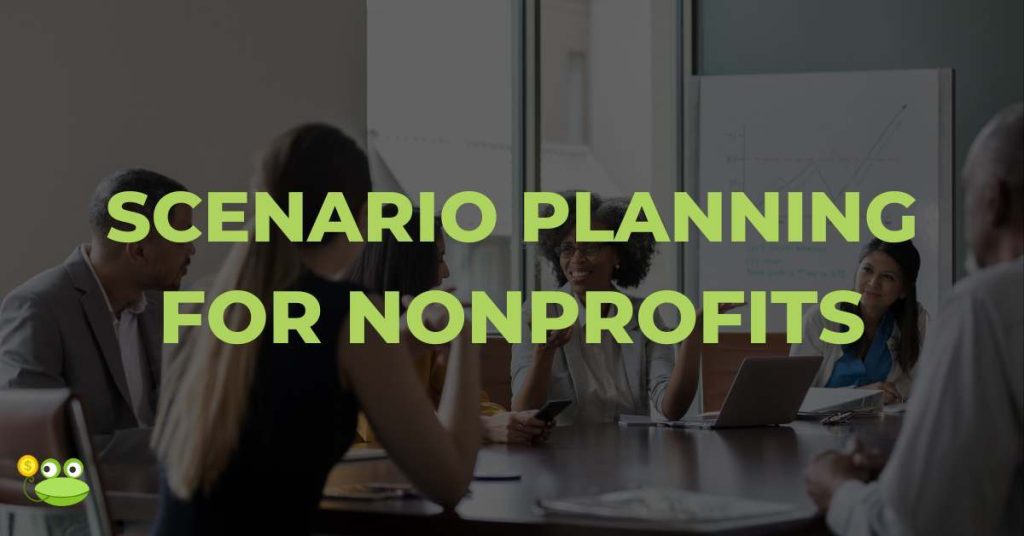Scenario planning for nonprofits
Nonprofit organizations navigate the same uncertainty as for-profit companies. It makes sense, then, that they need the same tools to mitigate risk and maximize upside. Our scenario planning software can help nonprofits chart a sustainable course through a volatile landscape.

Quick links
Intro to scenario planning
Scenario planning is a forecasting discipline based on evaluating a range of hypothetical future developments. It supports effective decision-making and has been used by some of the world’s most successful organizations.
In a scenario planning session, leaders ask “what if” questions and explore the outcomes of different contingencies. When done with the right framework (hint, hint: Profit Frog), scenario planning can result in robust modeling capabilities using an organization’s actual data extrapolated into hypothetical futures.
Now, the power of scenario planning is available at an affordable pricepoint for nonprofits to use.
Benefits of scenario planning for nonprofits
Scenario planning is incredibly beneficial to a non-profit’s longevity and bottom line. Some benefits of scenario planning include:
- Be decisive and move quickly. Nonprofit leaders can react quickly to external events because they’ve already modeled their response and have a plan.
- Have a competitive advantage over other nonprofits. Donors and stakeholders will be inspired by the decisiveness and vision with which an organization acts.
- Minimize risk by not being caught off guard. Because a non-profit has prepared for specific scenarios, they are less at risk because they can act quickly to keep the impact minimal.
- Maximize upside. A nonprofit can become more antifragile by being prepared to take advantage of opportunities introduced by change; meanwhile, unprepared counterparts cannot mobilize quickly enough to make use of the opportunity.
Smart nonprofits become smarter with Profit Frog
Scenario planning was once the province of mega-corporations with unlimited budgets and financial wizards on staff. Over the past several years, a new crop of scenario planning tools have emerged. Most of these cater to enterprise organizations and have a steep learning curve and too much complexity.
Profit Frog is the only scenario modeling tool that caters exclusively to smaller organizations. With an intuitive interface and the ability to dynamically model multiple scenarios easily, we give you everything you need…and nothing you don’t.
Our scenario planning software lets you model a range of possible outcomes and impacts. Then you can steer your organization toward best-case scenarios while being prepared for worst-case ones.
- Learn where to allocate resources
- Be strategically and financially prepared for a worst-case scenario
- Identify potential risk and turn it into gain
- Recognize and seize amazing opportunities
- Gain confidence in your decision-making skills by preparing for things you can’t control
- Be ready for disruptive change and take advantage of it
- Have a proactive rather than reactive orientation to the future
Scenario Planning vs Strategic Planning
Many nonprofits mistake strategic planning for scenario planning, when the two processes are actually quite different in orientation and result.
- Strategic planning assumes a known future outcome and strategizes how to get there
- Scenario planning assumes a dynamic, chaotic future and helps you plot the course to maximum profitability through all the unknowns
In other words, strategic planning is a more static process and is disrupted by variability, where scenario planning is designed to navigate variability.
Profit Frog’s scenario analysis is designed to be dynamically updated as conditions change. This sort of dynamic planning is much more effective and actionable than many static planning models.
Nonprofits that adopt scenario planning are better positioned for variability than those that undertake strategic planning alone.
Scenario planning FAQ
How does Profit Frog’s scenario planning software differ from other options on the market?
Other scenario planning software is overly complex and expensive. Ours is easy and affordable.
How do you create a scenario planning project?
Profit Frog is an effective scenario planning tool that allows you to model as many scenarios as you like, easily and quickly.
- Identify scenarios you want to model
- Input actuals (data about your organization) into Profit Frog
- Adjust variables dynamically to see how they influence scenarios
- Create an action plan and update it dynamically as conditions change
With a Profit Frog scenario plan, you can look at local or global scenarios with the lens of how they will impact your nonprofit. You can then look at the various alternative futures posed by those scenarios and develop a plan to navigate them.
Is there a free trial available for Profit Frog’s scenario planning software?
Yes, we offer a 14-day free trial of our software.
How to use scenario planning in situations caused by the Covid-19 pandemic?
In a world remade by the pandemic, every organization needs to invest in financial, strategic, and operational scenario planning. Profit Frog helps you model organizational viability across all types of scenarios, including disruptions caused by pandemics, supply chain issues, recessions, or other events.
How much does Profit Frog’s scenario planning software cost?
We price our software on a sliding scale based on total revenue. For custom pricing for your nonprofit, don’t hesitate to contact us for a custom estimate.
Further reading on financial management
What are the types of scenario planning and how are they used?
Understanding revenue vs profit
Advantages and disadvantages of scenario planning
Measuring year over year growth
Net profit vs gross profit metrics
A look at scenario planning models
Using profit and loss effectively
What are the best profitability modeling tools?
Making sense of P&L vs cashflow
Share this page